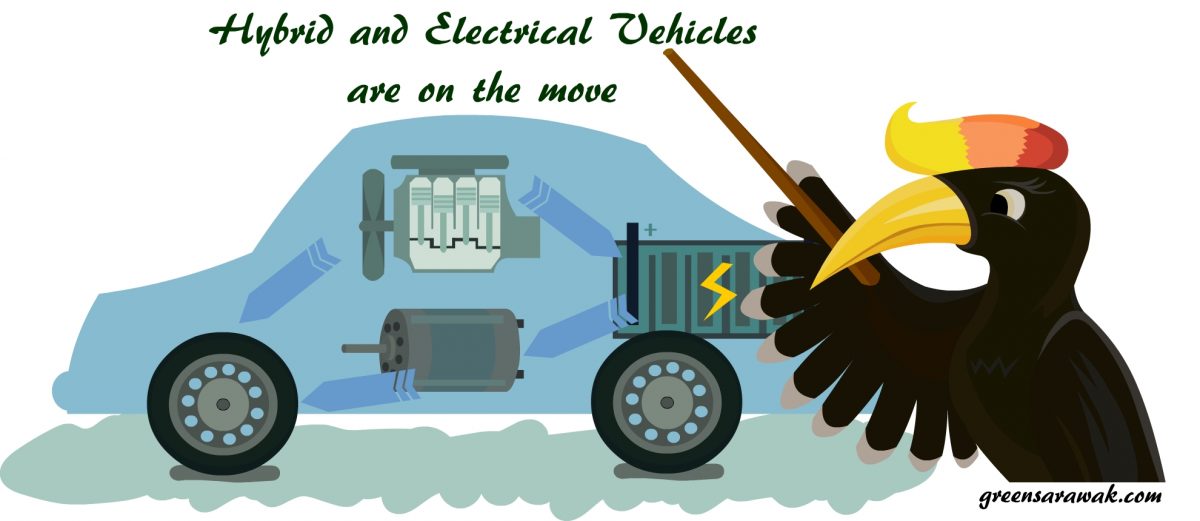Do you know that Hybrid and Electric Vehicles are slowly mature in the international market ? With currently technology, many limitations and myths of these “Environmental Friendly” Vehicles are broken.
Do you know that driving electrical vehicles in Sarawak is much more cheaper than driving electrical vehicles in Peninsular Malaysia ? What cause the difference?
How many cars are there in Sarawak
For decades we are dependent on petrol in our daily transportation, since the invention of the petrol engine for transportation. It had never being so affordable before. Number of vehicles are on the raise.
How many estimated road vehicles in Sarawak ? We can make a rough estimates by looking at the series of vehicle registration number (or commonly known as car number plate). Although the numbers does not reflect the actual number of cars on the road but it give just enough of rough estimates to tell the near figures of the numbers of vehicles that had been consuming our precious fossil fuel – Petrol.
In Sarawak, most district have their representing series in their vehicle registration number. In the city of Kuching, it started to use the Kx #### Q format series in the 1980s, where prefix K means Kuching and suffix Q means Sarawak. Every succession increase in the prefix (x will have range from alphabet A to Y) means 1-9999 had been registered for use.
Then In 1991 the new format was adopted, using QKx #### format series. The subsequently a another format being introduced, namely the QAx #### which also exhausted their series. Each format series would means near 230,000 vehicles been registered. (It is excluding the special characters like “I”, “O”, “Z” that not been use in consumer market.)
The latest numbers is using the QAA #### x format , which is running at QAA #### T to date. It puts nearly 200,000 vehicles been registered.
With every succession series, the rate of exhaustion is getting faster and faster, which corresponding to increasing in population and more people are affordable to get a vehicle.
Number of cars no only causing increase in commute time by increasing frequent traffic jams , it also increase the dependency on our non renewable resource – petrol. At the current stage, fuel is the lifeline of the city, the fuel price will affect the cost of living in cities.
The type of road vehicles in Market
The type of road vehicles can be classify by usage and form factors such as motorcycles, cars, vans, lorry, trucks etc. Another emerging classification is using propulsion system type. It is mainly due to newer emerging of new propulsion system that replacing the age old petrol only engines.
Below are the three main classification of vehicle by propulsion systems. Petrol vehicles, Electric vehicles and Hybrid Vehicles.
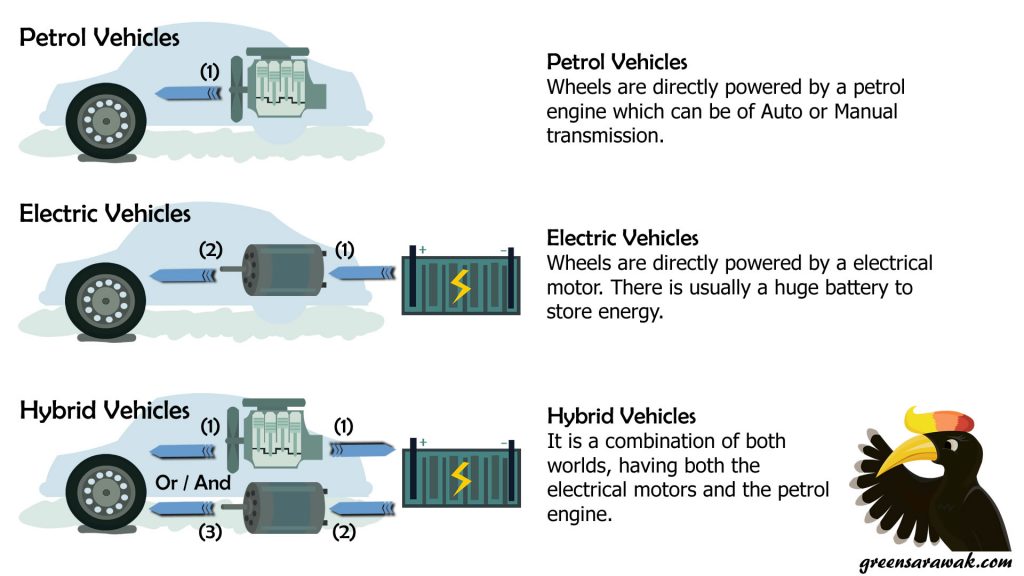
Petrol vehicles is still the main share of the market due to its long establishments and affordability. It is not uncommon to see more than two vehicles per family in Sarawak.
Petrol engine are known to be very efficient in higher speed driving, but with urbanization, there is more start stop cycles during city travels that reduce the efficiency of petrol only propulsion in city uses. The fuel is wasted mainly due to idle running engines during the wait for traffic.
Electrical vehicles will be the best choice of efficiency as current motors are very high in efficiency per wattage use, but having issues of less powerful accelerations and dependency on charging outlets which is lacking in implementation Malaysia.
Then comes the Hybrids, the complicated combination of both petrol and electrical engines. It solve the issue of charging the battery for the electrical motors as it can generate own electricity from the petrol engines.
With newer advancement in Hybrid technology, it can further classify as full hybrid or mild hybrid. Full hybrid is vehicle capable of using the petrol engine or electrical motor independently or simultaneously. Mild hybrid however uses electrical motor to assist the propulsion in order to increase efficiency of fuel consumption.
Depends on delivery system, it can also be classify into series hybrids, parallel hybrids and combined series-parallel hybrids.
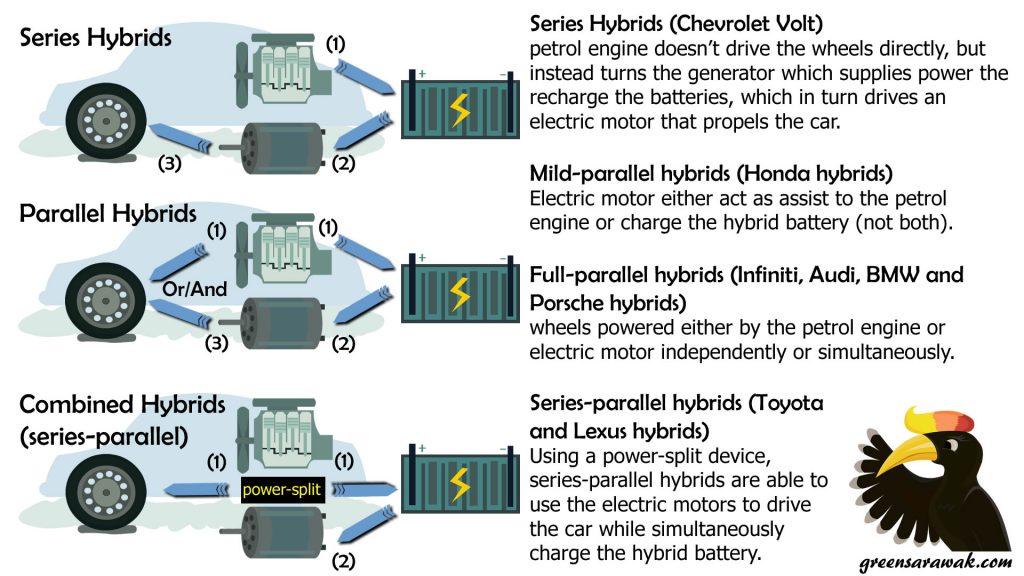
Due to concern about dependency on petrol engine to create electricity for the electrical motor, there is another emerging breed of Plug in Hybrids that further reduce the dependency on petrol engine. It allow the vehicle to be charged from the wall plug when resting at home or work.
Officially in the global market, it was estimated only 1% of the vehicles available globally have a plug on the car, which includes plug in hybrids and electric vehicles. This number is on the raise with the advancement in technology and mature of the manufacture process, which slowly cutting down the retail price of these vehicles and make it more affordable.
The Efficiency of Petrol Engine VS Electric Motor
A Petrol engine is considered less efficient than a Electric counterparts. So how much different it can on paper ?
Petrol engine (also known as Internal Combustion Engine) consist of the combustion cylinder complex and a transmission system with driveshaft components. The whole system was built to withstand heat from combustion and able to withstand shock, wear and tear.
The engine is usually build from die cast metal which is very heavy. The purpose of the thick engine wall is to prevent exploded engines as each combustion cycle in a petrol engine means a mini explosion of petrol fuel mix with air. The water cooling also act an important component to sink the heat that generated by combustion to prevent overheating. All these add to the weight which reduce the efficiency as these are dead weight that the engine have to drag during travel.
The next constrain is the transmission system. Since the engine must be running at a minimum sustained cycle to prevent sudden death of engine if it runs below a threshold. It is mainly because in a four stroke engine, the combustion cycle is the only process that release energy from fuel, while in other cycle like filling, compression and exhaust all require assisted energy from the combustion cycle from the neighboring cylinder. That’s why not all energy is transferred to the wheel. It will go through a series of conversion via drive shaft and gears. Part of the energy is lost here.
Hence the tank to wheel efficiency is still debatable low even with the modern petrol engines. You can’t take off much from the weight or the transmission system. The numbers quoted is around 30% efficiency.
What about cars with electric motors ?
Well, firstly, the electric motor is a very well established technology with very high efficiency, with 80% to 90% efficiency in converting electrical energy to movement. They are much lighter and hence less dead weight to drag around during transport.
They don’t have a complex transmission system like petrol engine do. The electric motors is connected to a drivetrain and single fixed speed gear, and hence energy is not loss during transmission.
Electric motor speed are direct controlled using AC from the speed controller. Things are sound much simpler and less to lose.
So Electric motor are the best and lets go all electric ! or it is not so ? Due to complex nature of Hybrid Vs Electric Vehicle, not all cars with electric motors are build equal.
In term of hybrids, the petrol engine still takes up significant weight, although it is build smaller and usually act in conjunction with electric motor to assist acceleration. The hybrid battery that store energy for the electric motor to run also takes up significant weight and space. Inverter in the electrical also loose some energy during converting the DC of the battery to AC that can be used in the Electric motors, although not by much.
The ideal world of balance weight and efficiency goes to Electric vehicle. Without a combustion engine, the system is far more simple and light weight. But without a charge station readily available around the country, many still worried about long distance travel. The car is dead when the battery is dead (you can bring a battery bank for your mobile devices but not for cars).
The electricity price VS the petrol price
In Malaysia there is three independent electricity board. In Peninsular Malaysia is handled by Tenaga Nasional Bhd (TNB). In Sabah and Labuan is handled by Sabah Electricity Sdn Bhd (SESB). In Sarawak is by Sarawak Energy Berhad (Sarawak Energy).
These three energy board have different tariff for their domestic electricity bill. TNB offers Tariff rates from 21.80 sen/kWh to 57.10 sen/kWh depends on usage. SESB in the other end offers Tariff rates from 17.50 sen/kWh to 47.0 sen/kWh depends on usage. Sarawak Energy offers Tariff rates from 18.0 sen/kWh to 31.50 sen/kWh depends on usage. Although it is subject to change.
From the comparison, Sarawak have the cheaper electricity tariff among the three. Mainly due to Sarawak having the Bakun Hydroelectric plant which stays the biggest of the Nation.
Anything has strike your mind ? With cheaper cost of electricity in Sarawak (although not by many), it shall favor the usage of Electrical Vehicles in Sarawak with comparing to Peninsular, Sabah and Labuan.
Lets do some math. Taking a Nissan Leaf Electric Vehicle into consideration, if you are a excessive electricity user and you are charge highest 57.10 sen/kWh in peninsular by tariff , you will have to pay RM13.70 to fully charge a 24 kWh battery of a Nissan Leaf to able to run 195km (estimated Max). With the same situation in Sarawak (31.50 sen/kWh highest domestic tariff), you will need to pay RM7.56 for the same benefit. Although it looks over-simplify, but it does makes driving electric vehicle in Sarawak is much more cheaper.
The Petrol prices are controlled across the nation, making no difference buying petrol in Peninsular Malaysia or Sarawak. Hence there is no fuel advantages in either side of Malaysia. With current fluctuation of fuel prices, it is hard to have a standard calculation. But the price to have same distance traveled will obviously been double or triple in a petrol only car.
The case of Toyota Prius in Malaysia
In the year 2013-1015, Malaysia citizen is blessed with a new type of full hybrid in Malaysia. It is the once famous Toyota Prius – comes with the full spec Prius and compact version called Prius C.
It initially create a hype in the market as it is a hybrid fit for city life, high efficiency with low fuel consumption. It have regenerative breaking and an advance power-split that allow it to be the most advance full hybrid of the market that time.
With the government effort to encourage the people to use hybrid vehicles, an incentive had been given for the buyer in the initial years. With tax relief, the price is retail around RM139k for Prius and RM97k for Prius C. Expensive but still affordable for some. However in 2015, Toyota decided to drop Prius and Prius C out of the Malaysia market as at the moment the tax relief incentives are ended, the price even reach RM216K and RM153K respectively, which cuts the demand drastically.
In the current market, most of the Prius and Prius C are model from the 2013-2014, and mostly in second hand market place. It becomes the story of the hype of hybrid that can be killed instantly when incentive is over.
So does that means Malaysia is not ready for a hybrid ? Not really. Many still love hybrid but the price of it is near the luxury range of vehicle.
The battery is of much concern
It is easy to say to stuff every car with a electric motor as it is the most efficient options available, but electric motor don’t run without electricity. Electricity don’t comes in any other forms except the charges stored in a battery.
Battery lifespan or the life expectancy is much of the concern when comes to EV or Hybrids. Many takes a step back as wondering about the cost to change the hybrid battery every 10 years that cost near RM10K (in case of Prius). This raise the concern that the price of the battery change will offset the money saved from the reduced fuel consumption. This concern was debuted as hybrid battery is much better build and controlled by sophisticated power management system which prevent extensive deep charge cycle and prolong the life expectancy of the battery with a estimated minimum service life of 15-years or 240,000 km.
Another concern is Battery life. A battery life is not infinite. Like other mobile devices, you still need to get it charged somehow or the other. The battery that runs the electric motor need to be charge from a source, either a internal combustion engine like hybrids, or a plug in case of plug in hybrids or electric vehicle. With limited charging stations available nationwide, many took a step back. However research shows that many city dwellers don’t travel long distance everyday, instead the commute time increases as the city road gets jammed with other vehicles. Well, it is a difficult decision to made, either they need more charge station available nationwide or have two type of vehicle at home – Electric vehicles for city travel and hybrid for longer distance travel.
To put in perspective, a rechargeable battery is not as green as you might expected. Most hybrids use nickel-hydride and lithium-ion batteries. Nickel is a probable human carcinogen and improper disposal of nickel-hydride batteries can be hazardous to the environment (although it is less hazardous than lead acid or nickel cadmium counterparts). Lithium-ion however is the next big thing in hybrid cars. It is less toxic or hazardous than lead or nikel counterparts, but still depends on what is the other material that is combined with lithium (cobalt is toxic to the environment if it is used in lithium-ion battery).
The increase demand of nickel, lithium and cobalt for building rechargeable batteries also increase the mining of these material which can hazardous for the environment and miners as well. Moreover Lithium is one of the rare earth minerals that only concentrate in certain parts of the earth like China, Bolivia and Chile. Will it be another gold rush for lithium mining ? Time will tell.
With all these environmental concern, car manufacturer are opt to collect used hybrid batteries in order for recycling. Recycling is the only key. Hence don’t throw them in landfills.
The concern about green energy in electric vehicle
You got a plug-in hybrid or a electric vehicle. Yay ! lets celebrate ! Do we not ?
Even these vehicle are very much efficient than petrol engine counterparts, but don’t get the joy high yet. Electric vehicle are not part of green energy package unless the source of the primary energy production is also “green”.
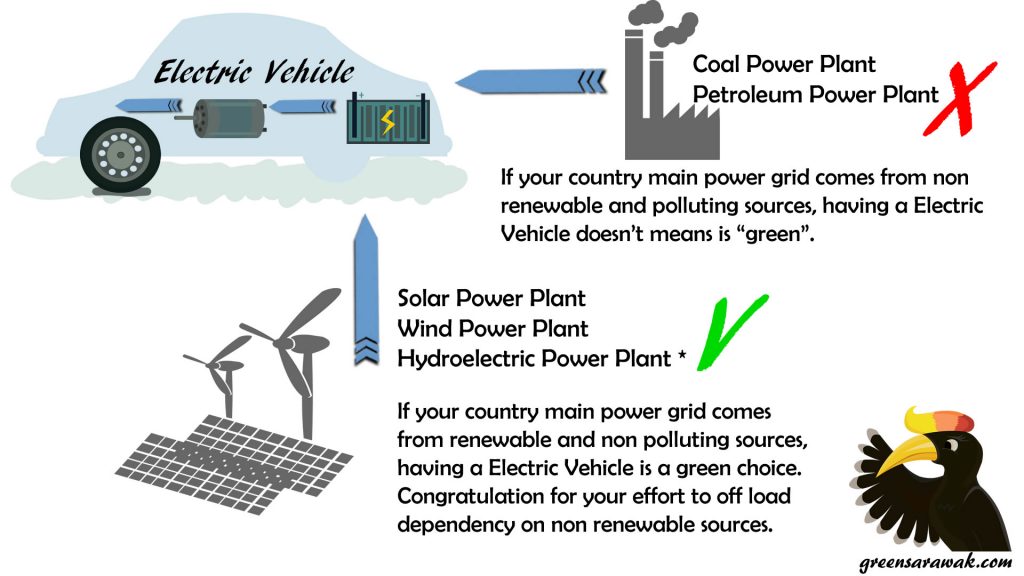
In country heavily dependent on coal and petroleum for their power grids, it will make the decision no longer green. What you did is just off load the the power generation from a car to the power grid.
Luckily for Sarawakian, Our Sarawak Energy is already embark on a journey of sustainable , non polluting and renewable energy generation for a long time. The Batang Ai and Bakun Hydroelectric Power stations generate enough power to meet the needs of the state. Hence it is still consider “green” (although not 100% if you consider other environmental damage that can lead from the dam, but it is still the best shot compares to other country).
The next step in Putting Plugs in every car
Despite lack of hybrids in the road and Prius are dropped from the market, newer hybrids still emerging in the Malaysian market in the luxury range.
Toyota still offer hybrid in their top Camry class. Honda still selling their affordable mild hybrid in their new Honda City Hybrid and Honda Jazz Hybrid. In the luxury range we have BMW newest offer of plug in hybrids (c350e) that is local assembled.
More and more new hybrid and electric vehicles will be populating the local market. Speculation of the merging of Proton and Geely will benifit the local market with affordable electric vehicle as Geely have their range of Electric Vehicle namely Geely Emgrand EV300 which is common in the China market. Nissan also offer Serena S-hybrid and Nissan Leaf EV.
It is a long way before we can put plugs in every car in the local market, but like any other technology advancement, it will take a gradual slope before the appreciable change in the market that leap in momentum which is illustrated as an “S-Curve”.
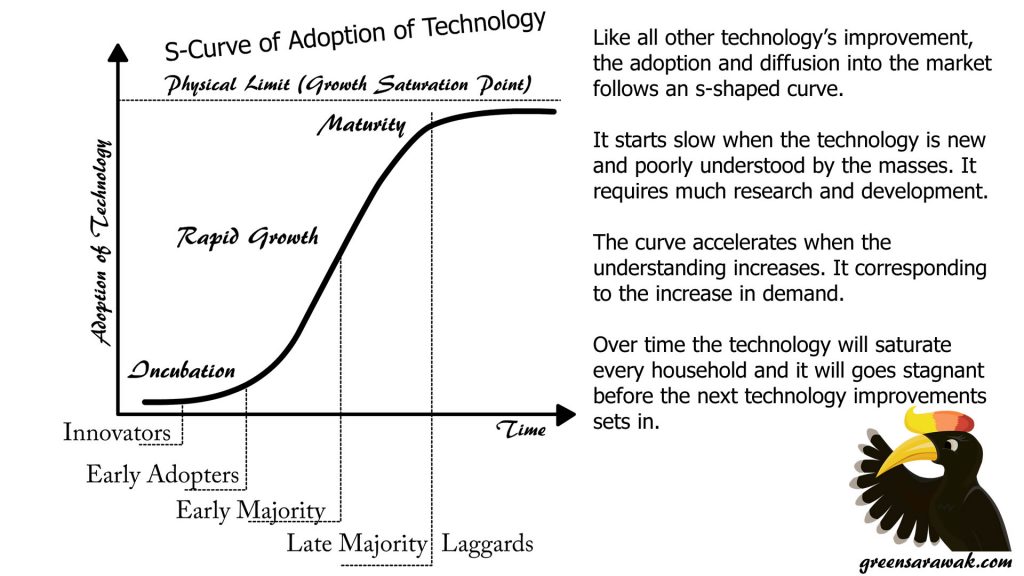
It is sooner than you might think. Stay tuned.

